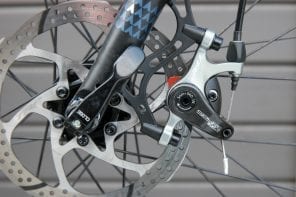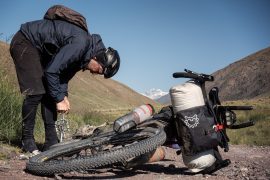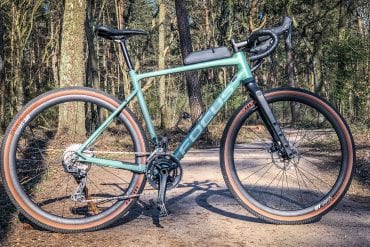I’m currently putting together my equipment for the Trans Balkan Race and have shared my thoughts on which air pump to take with me on Instagram.
Let me put it this way: the topic is obviously emotional and I have rarely received so many replies and comments.
So I decided to take a more fundamental approach to the topic of bikepacking air pumps and combine it with a test.
Table of Contents
The air pump candidates
Obviously, I now have four small air pumps and two floor pumps. I wasn’t fully aware of the number of pumps I have, but that’s what tests are good for 🙂
However, this is about the four small pumps that are used when travelling in the event of a puncture:
- The Blackburn AirStik SL
- The Silca Tattico
- The BBB Cycling DoubleShot Mini
- The Lezyne Micro Floor Drive HVG

The test set-up
To create a uniform test situation, I grabbed my rear wheel from the Bombtrack Beyond, which is 29 inches and has a 2.2 inch wide Continental RaceKing tyre and tube.
I also quickly bought an electronic air pressure gauge from Schwalbe so that I had a standardised database.

The tyre was set to 0 bar for the test. I then gave 100 pump strokes into the tyre/ inner tube with each pump and measured the pressure then present. I did the same again with 200 pump strokes.
To be on the safe side, I did this test at least twice per pump to rule out any incorrect measurements.
I can’t say whether there are any differences between tubeless tyres and the tubular tyres from my test in terms of pump performance. It should also be noted that the values may differ for narrower tyres and may be higher, for example.
The results
Blackburn AirStik SL

Stephan once gifted me this very small and lightweight pump. It is ideal for bikepacking, takes up hardly any space and fits in any bag or jersey. At 60g (weighed by myself) and a length of 16 cm, it really is very compact. Like all the pumps in the test, it is made of aluminium.
Officially, it should be able to build up a pressure of up to 11 bar.
You simply attach this pump to the valve and start pumping. When pumping, however, you have to be careful not to accidentally pinch your finger at the front. The start of the test was slightly painful, but this could also have been due to the tester’s lack of qualifications.
The 100 pump strokes are quite easy and the pump head does not get warm. At the end, the Blackburn has an air pressure of 0.31 bar in the tyre. After 200 pump strokes, a pressure of 0.77 bar is reached. Not bad.

If I assume a target pressure of 1.9 bar, then mathematically it takes around 500 pumping strokes to achieve this. That sounds like a lot, but I believe that in practice this is quickly achieved.
The price of the AirStik SL is 28 euros, which is ok. For this you get a well-made pump that is very light and compact. And which – with a little patience – will also get air into the tyre. However, on a road bike with a target pressure of at least 4 bar, this would take too long for me.

Silca Tattico

I once bought the Silca as an alternative to the Lezyne pump (see below). It has a very high quality finish, is also made of aluminium and weighs 156g (weighed by myself).
With the Tattico, you pull the head out of the pump with a hose and then clamp it to the valve. The pump then works like a normal air pump and is 41.5 cm long when extended. When assembled, the Tattico is 24.5 cm long and 2.5 cm wide.
Depending on the valve type, the head can still be changed. So from car valve to French valve and vice versa. The clamping is advantageous because it secures the head and the pump can also be used on valves that do not have a thread. This is the case, for example, with Schwalbe Aerothan or Tubolito tubes.

However, I have also managed to bend the valve head slightly with the Tattico. Pumping also creates a movement. This then caused the pump head to move and, despite being clamped, to loosen slightly, causing the valve head to bend. But if you know this, you can prevent it and work without damage.

Although the pump head on the Tattico is pushed together and protected by a rubber cap, dust and dirt get in over time, which means that the head can no longer be pulled out of the pump so easily. I therefore usually use my teeth to loosen it and pull it out.

In the test, the Tattico built up a pressure of 0.43 bar in the tyre after 100 pump strokes. I would have expected a little more. But after another 100 pump strokes I already have a pressure of 1.22 bar. That’s not bad. Of course, the pump body gets a little warm when pumping, but not uncomfortably so.
According to the manufacturer, the Tattico can pump up to a maximum of 7 bar.
The price of the Silca Tattico is 85 euros, which makes it the most expensive air pump in this test.

BBB Cycling DoubleShot Mini

This new pump from BBB is interesting because, in principle, a “normal” air pump has been split and put together compactly. And if the previous reports about this pump are to be believed, then it must also be able to deliver plenty of air.
At just 83g, the BBB is the second-lightest pump in this comparison (weighed by ourselves), but it also costs 60 euros. It is made of aluminium and consists of two parts which are then screwed together for pumping. It then has a length of 36 cm and, according to the manufacturer, can deliver up to 8 bar.
The pump parts are pushed together for transport. This makes them 12 cm long x 4 cm wide. This makes it pleasantly compact and ideal for transport when space and weight are important.

After 100 pump strokes, the BBB has built up an air pressure of 0.35 bar. That’s only a little more than the Blackburn. And 19% less pressure than the Tattico after 100 strokes. I even did the test several times with this pump and the lowest air pressure reached was only 0.26 bar. However, I was able to replicate 0.35 bar after 100 strokes more often. After 200 pump strokes, the pressure was 0.95 bar, 23% higher than the Blackburn.
I would have expected a little more, but the BBB is probably just average with these values, given its compactness and weight. However, 60 euros is a bit much in my opinion.

Lezyne Micro Floor Drive HVG

This is my second Lezyne Micro Floor. The first one broke down two years ago and could no longer be moved. This was probably mainly due to the fact that the pump was always mounted outside on my rides and was exposed to dirt and dust without protection.
The Micro Floor differs from the other pumps in that it is a mini floor pump. One foot can be folded out to the side and the pump head with hose and, depending on the version, pressure indicator screwed onto the valve.

When extended, the Lezyne is 50 cm long and the small T-handle at the end of the pump is very comfortable to use. However, the Micro Floor is also known for the fact that the valve is often unscrewed after pumping because the pump head is screwed to the valve. This happened to me shortly before the start of the Bohemian Border Bash Race, for example. And once in Kyrgyzstan, where I noticed it and was able to react quickly.

This disadvantage is really annoying, because otherwise this air pump is my clear favourite and was always there when it really mattered.
It weighs 191g (self-weighed) and is therefore the heaviest pump in this test. However, it delivers the best performance in comparison: after 100 pump strokes, the air pressure in the tyre was 0.76 bar. After a further 100 pump strokes, I had reached a pressure of 1.44 bar in the test. That’s very good and very fast. Compared to the Tattico, the Micro Floor was able to build up 18% more pressure in the tyre.
According to the manufacturer, the Micro Floor brings a maximum of 6 bar to the tyre.
But you shouldn’t compare the Blackburn or the BBB with the Lezyne. These are simply different requirements, because the Lezyne has more volume and power.
Compared to the Tattico, the Micro Floor is slightly better (43% more pressure after 100 strokes, 18% more after 200).

The Micro Floor also takes up a little more space than the Tattico, as it measures 30cm long x 5cm wide when compressed. I usually carry it on the side of the seat tube in the Lezyne holder.

I never use the pressure indicator because the plastic is already dull and so I can’t see much. However, the hose has proven to be very robust. On my old Lezyne it once fell out of the bottom of the pump base and I thought it had broken off. But I was able to screw it back in.
The Lezyne Micro Floor is also made of aluminium and costs 60 euros.

Conclusion

For now, I take the Lezyne with me into the Balkans. Despite the extra weight, I have a better feeling with it and can rely on it more. And an air pump is a critical piece of equipment.
However, the Silca Tattico is not quite out of the race either. It is only slightly behind the Lezyne in terms of performance and has a clamp and is not screwed on. It is also slightly lighter, but this is negligible.
I also find the BBB and the Blackburn interesting, but would currently “only” consider them as pumps for my training rides or bikepacking trips in regions where there is sufficient infrastructure.

I sometimes have two CO2 cartridges with me. However, I have also had the experience with gas that the valve head has been damaged by the cold when it is released to such an extent that it has broken off. Shock-frozen.
I always carry a valve attachment with me so that I can inflate my tyres with a French valve at petrol stations.
I also look with interest at the new and very compact electric pumps. These usually weigh around 100g and have enough power to inflate the tyre at least twice. Afterwards, they can be easily recharged via USB. If I ever get the chance, I’ll try out one of these pumps.
And if any of you have already had experience with such an electric pump in a bikepacking context, please write in the comments.
If you would like to recommend other pumps, please do the test first: empty tyre, specify which size/tubeless or inner tube, 100/200 pump strokes and then measure the pressure and post it in the comments. Thank you!






Hi Nils,
schöner Blog, kurz meine Erfahrungen ergänzend.
ein unbedingtes Yes! Für die Nutzung von Handpumpen und gegen CO2 Kartuschen. Denn diese Luft ist endlich und es entsteht unnötiger Müll.
Die Pumpen Auswahl muss unbedingt nach Volumen und Druck der in Verwendung befindlichen Reifen erfolgen.
In der Praxis bewährt:
Pumpe die beim Pumpen den Druck anzeigt, dass vermeidet folge Platten da Druck korrekt eingestellt. Und Zeitersparnis da keine mehrfach Montage der Pumpe am Ventil notwendig.
Pumpen mit Schlauch zur Montage am Ventil um das Ventil beim Pumpen nicht zu beschädigen. Man kann so z.B die Pumpe hinten gegen den Zahnkranz vom Ritzelpaket fixieren und hat so eine sehr gut fixierte Pumpsituation.
Pumpen gehören gepflegt genau wie das Rad.
Pump Anschlüsse sollten schraubbar sein. Um eine sichere Verbindung her zu stellen.
Besser vorsorgen als viel Pumpen
Viele fahren mit viel zu viel Druck in den Reifen. Und kontrollieren den Druck viel zu selten. Auch gehören die Reifen vor der Fahrt und gegebenenfalls bei der Fahrt wenn zum Beispiel sichtbar Scherben auf dem Boden gelegen sind, kontrolliert. Vorausschauendes fahren gehört auch dazu, dort wo die Reifen, Beifahrer Seite, der Autos rollen, ist die Straße am saubersten und nach meiner Erfahrung am sichersten.
Daraus ergibt sich:
wenig Zeitaufwand vor der Tour „Kontrolle“ erspart den ein oder anderen Platten und Sturz!
Pumpe muss zu Reifen und Nutzer (Handkraft) passen.
Bei Pumpen würde ich nicht so auf das Gewicht schauen. Es nutzt gar nicht, etwas leichtes mit zu nehmen, was dann im Fall der Fälle nicht funktioniert. Dann kann ich das gleich ganz weg lassen.
Kette rechts Thorsten